I’ve tried a lot of the Arcteryx pieces over the years, some have worked out for me and some haven’t. (What can I say; they just don’t match my eyes.) Today, I thought I’d give a quick run down of which jackets I like best for 2011. Occasionally, like during the shoulder seasons or maybe for overnight missions, I may substitute in a different jacket, but 99% of the time, these are the ones I will be wearing when backcountry skiing this year.
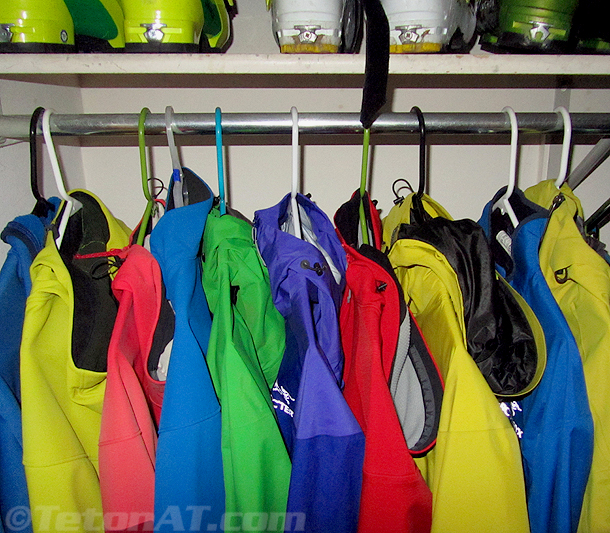
Arc’teryx makes some pretty colorful jackets, but surprisingly,
I get the most compliments when I’m wearing Squid Ink.
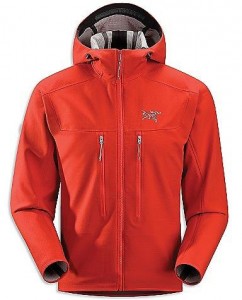 Acto MX Hoody– When skinning and booting, I like to wear highly breathable, lightweight jackets that have nice hoods and low profile wrist cuffs that I can push up my arms easily to dump heat. The Acto MX Hoody is new for this season and found under Arc’teryx’s Hardfleece Collection.
Acto MX Hoody– When skinning and booting, I like to wear highly breathable, lightweight jackets that have nice hoods and low profile wrist cuffs that I can push up my arms easily to dump heat. The Acto MX Hoody is new for this season and found under Arc’teryx’s Hardfleece Collection.
I’ve used the Acto a few times in the last month and it has taken over the top spot for me as far as approach jackets go, which used to be held by the Epsilon SV Hoody. (Previous Epsilon SV reviews here and here.) The fabric of the Acto is similar in weight to the Epsilon, but it has a grid-like pattern built into the inside lining (Aerius Grid Loft) that allows for increased air permeability. IMO, breathability is the most important characteristic in a soft-shell approach jacket, at least for backcountry skiing, so this is the biggest reason I like the Acto over the Epsilon.
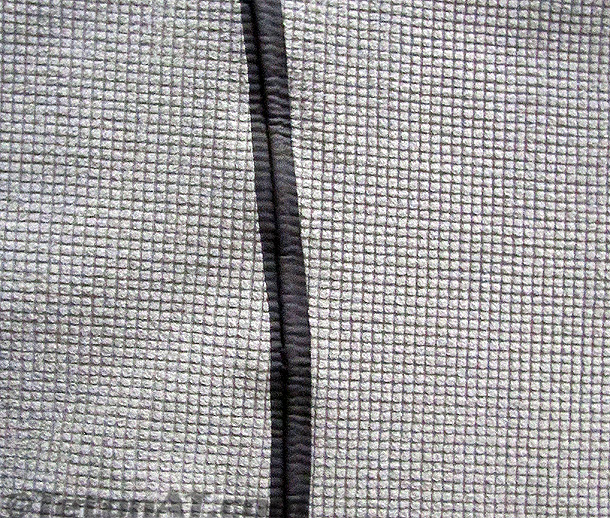
The Aerius Grid Loft fabric is what makes the Acto MX Hoody so breathable.
Some noted features of the Acto are its two napoleon pockets, which take a little getting used to compared to regular hand-warmer pockets, but are much more functional when you are wearing a backpack since their contents are held up and out of the way of a pack’s waist belt. They are also mesh lined, which makes them work great for venting as well. The wrist cuff construction is very low 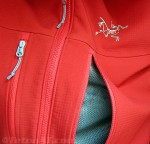 bulk, fits under gloves easily and also stretches just enough for when you want to push up your sleeves. The hood seems a bit larger than the Epsilon, which makes it fit over a helmet better, but a nice brim and draw cords allow you to cinch it down for more protection from the weather when you need it. The overall fit of the Acto is very slim and athletic (more so than the Epsilon), which makes layering nice and keeps my beer-belly in check.
bulk, fits under gloves easily and also stretches just enough for when you want to push up your sleeves. The hood seems a bit larger than the Epsilon, which makes it fit over a helmet better, but a nice brim and draw cords allow you to cinch it down for more protection from the weather when you need it. The overall fit of the Acto is very slim and athletic (more so than the Epsilon), which makes layering nice and keeps my beer-belly in check.
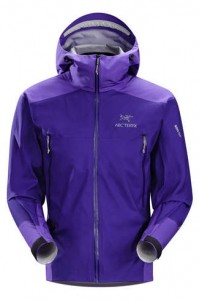 Beta FL– It’s is rare occasion when I carry a light, waterproof shell when backcountry skiing (it’s pretty cold and dry here in the Tetons), but for missions in the spring when you encounter warmer and wetter conditions, a Gore-Tex shell is a must. The FL (Fast and Light) series is new for Arc’teryx this year and uses a new fabric from Gore-Tex called Active Shell.
Beta FL– It’s is rare occasion when I carry a light, waterproof shell when backcountry skiing (it’s pretty cold and dry here in the Tetons), but for missions in the spring when you encounter warmer and wetter conditions, a Gore-Tex shell is a must. The FL (Fast and Light) series is new for Arc’teryx this year and uses a new fabric from Gore-Tex called Active Shell.
One of the main complaints you hear about waterproof fabrics is their lack of breathability and moisture management during high output activities. GORE has addressed this with its new Active Shell by using a new lamination technology that integrates the inner lining to the Gore-Tex PTFE membrane, which not only reduces weight and bulk, but also has increases breathability and water vapor transmission (RET<3). Active Shell is still a 3-layer fabric, but it’s now thinner, lighter and more breathable than any of the other Gore-Tex fabrics. I got caught out at ~11k’ this summer in a torrential downpour (like flash-flood style), had to run back to the trailhead and stayed dry from the inside and out while using Active Shell, so it seems to work pretty well.
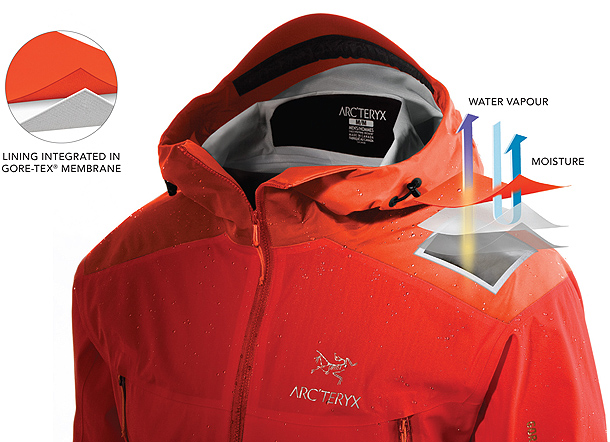
A thinner PTFE membrane with an integrated liner fabric is what
makes Gore-Tex Active Shell breath and transport water vapor so well, while still
remaining a waterproof and durable 3-layer fabric.
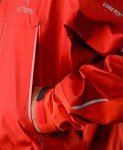 I like the Beta FL over the Alpha FL because it has more pocket space. If it’s raining out, I’m not stopping, so it’s nice to be able to stash essentials like energy food in the pockets to keep you going. Higher abrasion areas like the shoulders and hips get a beefier face fabric for added durability. Like the Acto, the Beta FL has a slim, athletic fit. I’m 5’ 8.999â€/165lbs and the medium fits me perfectly.
I like the Beta FL over the Alpha FL because it has more pocket space. If it’s raining out, I’m not stopping, so it’s nice to be able to stash essentials like energy food in the pockets to keep you going. Higher abrasion areas like the shoulders and hips get a beefier face fabric for added durability. Like the Acto, the Beta FL has a slim, athletic fit. I’m 5’ 8.999â€/165lbs and the medium fits me perfectly.
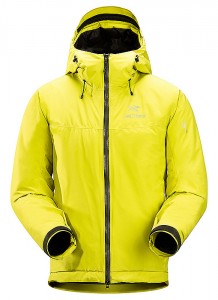 Fission SL– Wind and weather protection, warmth and durability are the key characteristics I look for in a descent jacket. The Fission SL is not cheap, but I find it is the perfect jacket for when you get the top of a peak, need to stay warm and dry, and are ready to ski.
Fission SL– Wind and weather protection, warmth and durability are the key characteristics I look for in a descent jacket. The Fission SL is not cheap, but I find it is the perfect jacket for when you get the top of a peak, need to stay warm and dry, and are ready to ski.
Waterproof insulated jackets are quite popular these days and Arc’teryx was one of the first to incorporate these features into a technical piece, as opposed to just a big, puffy parka. The Gore-Tex outer fabric allows me to wear the Fission SL over my soft-shell (where a non-waterproof insulated jacket would get wet) and offers fantastic protection from the elements. The Gore-Tex fabric is also more durable than a simple nylon fabric that might rip when you are skiing and bashing through trees.
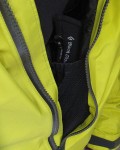 The Fission is very clean in design and is constructed with a micro seem allowance and Tiny GORE seam tape to reduce bulk and weight. The synthetic
The Fission is very clean in design and is constructed with a micro seem allowance and Tiny GORE seam tape to reduce bulk and weight. The synthetic 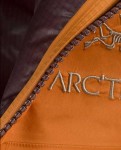 insulation is laminated to the inner fabric to keep it in place, reduce cold spots and makes baffles or quilting obsolete. Two fleece lined hand-warmer pockets on the outside are perfect for when you are chilling or refueling w/o gloves and the two big mesh pockets inside are a perfect place for storing those gloves. (A previous video review of the Fission SL can be read here.)
insulation is laminated to the inner fabric to keep it in place, reduce cold spots and makes baffles or quilting obsolete. Two fleece lined hand-warmer pockets on the outside are perfect for when you are chilling or refueling w/o gloves and the two big mesh pockets inside are a perfect place for storing those gloves. (A previous video review of the Fission SL can be read here.)
Anyway, I like to keep it simple when layering for backcountry skiing, and using these pieces here in the Tetons has worked well for me in most conditions. Looks like some fresh pow in the hills today, but I’m back to work so you will have to ski it for me. Ciao for now!

A jacket better than the Epsilon? Hard to belive, but seeing that mine is about spent perhaps I should look into the Acto MX…
yeah mr smoke…the acto if definitely more breathable than the epsilon and more slim fitting. a great piece.
Always interesting to read the layering systems of folks in different ranges. Obviously the Teton’s are cooooooold so you need that lined, puffy/G-tex downhill shell. Here in the Sierra, I always find myself skinning in a base layer or, if is is cold, just like an R1. The softshell is also the downhill shell, and I like my unlined completely with no insulation and highly-breathable. I run hot though.
Don’t really know much about the Arcteryx line – but my all time fav softshell is the Patagonia Readymix, which was then called the Ascenionist (still rocking). I think there is a new name for it now though.
cook nick. i remember back in the day i had a patagonia mixed master that i liked…maybe the predecessor to the ready mix?
I’m curious about the Acto hoody and I was hoping you could compare it to the Epsilon SV-which I have-on a few points. No shops around my neck of woods stock this piece and it looks more promising than the epsilon or gamma mx so…
Have you found it to be more or less breathable?
Is the weather resistance the same, especially the wind blocking?
It looks like it would be warmer due to the loftier looking grid material, would it be comparable to an R1 hoody for insulation?
Does the material/cut move better for climbing compared to the epsilon?
Can you wear it under an atom lt of the same size?
Basically I’m hoping the Acto is slightly warmer, better breathing, same wind proofness and with a much better cut for climbing than the Epsilon. Is it?
PS love the blog, keep up the stoke!
hey BB…this is what i can tell you about the acto compared to the epsilon…
Have you found it to be more or less breathable?
-The Acto is definitely and noticeably more breathable than the Epsilon SV Hoody.
Is the weather resistance the same, especially the wind blocking?
-They both have similar moisture resistance, but I would say the Epsilon is more wind resistant.
It looks like it would be warmer due to the loftier looking grid material, would it be comparable to an R1 hoody for insulation?
-I don’t think the Acto is warmer than the Epsilon. The grid allows for more air permeability and isn’t loftier. Trapped under another garment, you might be able to trap air in the grid pattern, but I don’t think it works the same as the R1 fleecy grid.
Does the material/cut move better for climbing compared to the epsilon?
-I’d say it the Acto fabric might be a little stretchier than the Epsilon.
Can you wear it under an atom lt of the same size?
-Yes. The Acto fit’s quite trim…and easily layers under and Atom.
Basically I’m hoping the Acto is slightly warmer, better breathing, same wind proofness and with a much better cut for climbing than the Epsilon. Is it?
-I don’t think the Acto does all those things, but it does do some of them since it fits trimmer and has more breathabiltiy. I think it would be hard to produce something that has has all those characteristics…compared to the Epsilon.